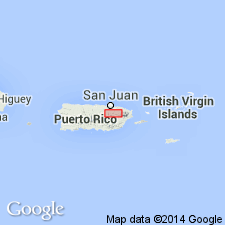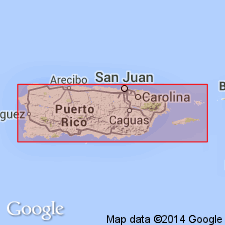
- Usage in publication:
-
- Naranjito Formation*
- Modifications:
-
- Named
- Dominant lithology:
-
- Tuff
- Mudstone
- AAPG geologic province:
-
- Caribbean region
Summary:
The Naranjito Formation, here named, consists of thick-bedded tuff and tuffaceous mudstone in a narrow faulted graben; stratigraphically equivalent to the Guaracanal Andesite. Top and bottom cut out by faults. Thickness is 300 m. Age is Paleocene based on equivalence to the Guaracanal.
Source: GNU records (USGS DDS-6; Reston GNULEX).

- Usage in publication:
-
- Naranjito Formation*
- Modifications:
-
- Age modified
- AAPG geologic province:
-
- Caribbean region
Summary:
The Naranjito Formation occurs in eastern Puerto Rico and consists of crystal-tuff, tuffaceous breccia and conglomerate, volcanic sandstone, and locally, lava flows. Maximum thickness is 450 meters. The age of the Naranjito Formation is changed to Late Cretaceous(?) and early Paleogene(?).
Source: GNU records (USGS DDS-6; Reston GNULEX).
For more information, please contact Nancy Stamm, Geologic Names Committee Secretary.
Asterisk (*) indicates published by U.S. Geological Survey authors.
"No current usage" (†) implies that a name has been abandoned or has fallen into disuse. Former usage and, if known, replacement name given in parentheses ( ).
Slash (/) indicates name conflicts with nomenclatural guidelines (CSN, 1933; ACSN, 1961, 1970; NACSN, 1983, 2005, 2021). May be explained within brackets ([ ]).

